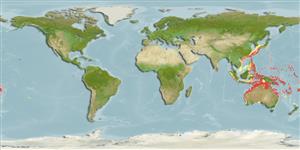Classification / Names
Common names from other countries
Main reference
Size / Weight / Age
Max length : 30.0 cm TL male/unsexed; (Ref. 3132)
Environment
Marine; reef-associated; depth range 26 - 137 m (Ref. 58489)
Climate / Range
Tropical, preferred ?
Distribution
Indo-West Pacific: Northern Australia and Arafura Sea. Does not occur in southern Australia or New Zealand (Ref. 9680).
Countries | FAO areas | Ecosystems | Occurrences | Introductions
Short description
A set of 4 long spines with their bases near dorsal- and anal-fin bases and their pointed ends extending over caudal peduncle. Two very long spines (longer than rays of pectoral fins) in pectoral-fin axil (Ref 9680).
IUCN Red List Status (Ref. 115185)
Threat to humans
Venomous
Human uses
Fisheries: of no interest
More information
ReferencesAquacultureAquaculture profileStrainsGeneticsAllele frequenciesHeritabilityDiseasesProcessingMass conversion
Tools
Special reports
Download XML
Internet sources
Estimates of some properties based on models
Phylogenetic diversity index
PD50 = 1.0000 many relatives (e.g. carps) 0.5 - 2.0 few relatives (e.g. lungfishes)
Trophic Level
3.5 ±0.37 se; Based on food items.
Resilience
Vulnerability
Low vulnerability (16 of 100)
Price category
